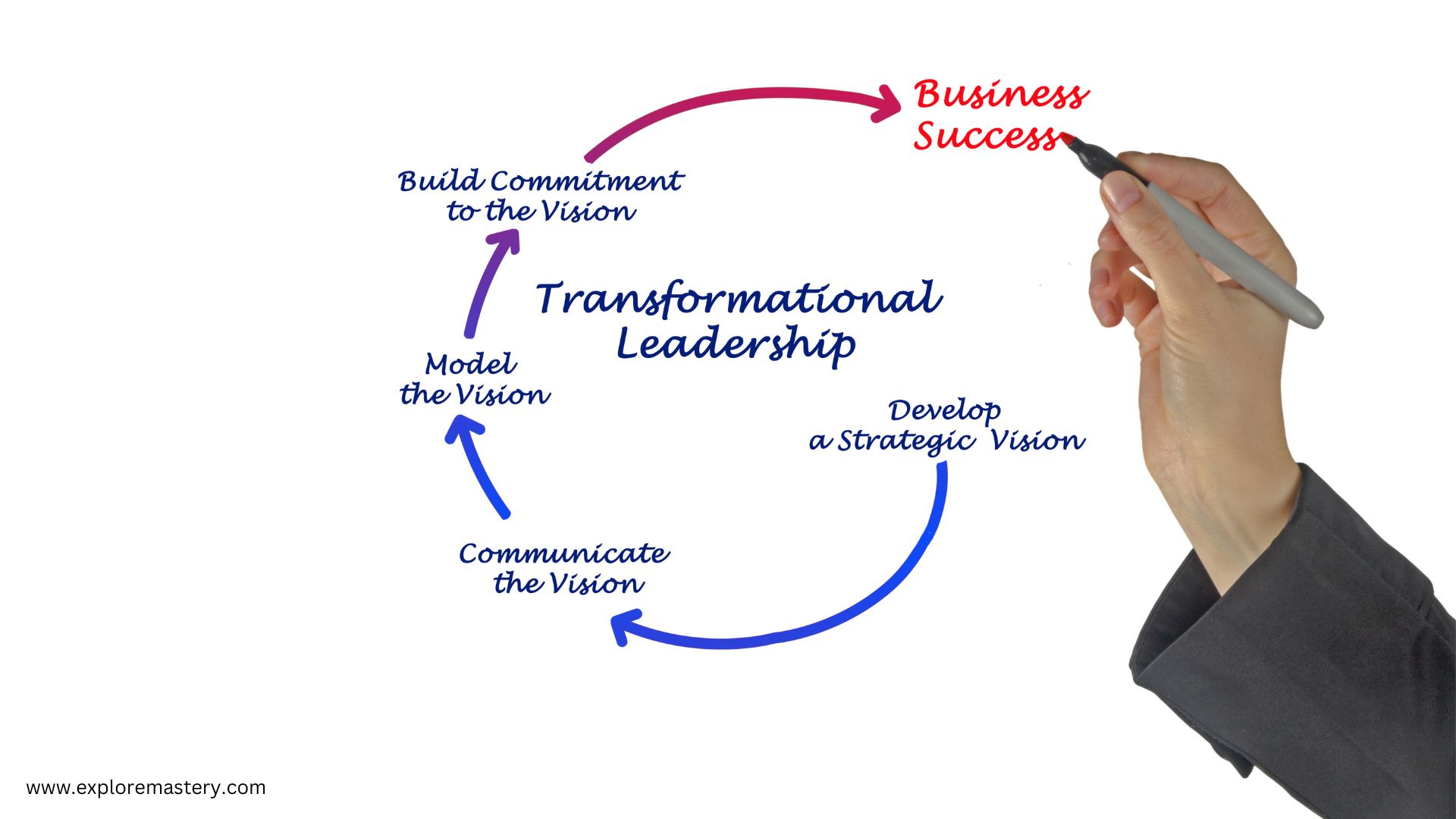In the dynamic world of organizational management, understanding different leadership styles is crucial for fostering growth and achieving goals. Two prominent styles that often come into focus are transactional leadership and transformational leadership. While both have their unique strengths and applications, they operate on fundamentally different principles. This article delves into the core differences between these two leadership styles, providing insights into their respective advantages and ideal applications.
Overview
- Transactional leadership is based on exchanges and transactions, utilizing rewards and punishments to manage followers.
- Transformational leadership focuses on inspiring and transforming followers through vision, innovation, and personal growth.
- Transactional leaders are effective in maintaining the status quo and ensuring task completion, while transformational leaders drive change and innovation.
- Both leadership styles have their own advantages and are suitable for different organizational contexts and situations.
- Understanding the key differences between transactional and transformational leadership can help leaders apply the most effective style based on the situation.
Table of contents
- Overview
- Introduction: Setting the Stage
- Transactional Leadership: The Nuts and Bolts
- Transformational Leadership: The Magic Wand
- Key Differences Between Transactional and Transformational Leadership
- When to Use Each Leadership Style
- Common Misconceptions and FAQs
- Conclusion: Wrapping It All Up
- Conclusion
- Frequently Asked Questions
- What is Transactional Leadership?
- What is Transformational Leadership?
- What are the key differences between Transactional and Transformational Leadership?
- Can a leader be both Transactional and Transformational?
- Which leadership style is better: Transactional or Transformational?
- Do followers prefer Transactional or Transformational Leadership?
- What are some famous examples of Transformational Leaders?
- What are some famous examples of Transactional Leaders?
Introduction: Setting the Stage
Why Leadership Styles Matter
In the vast leadership archives, you’ll find a treasure trove of wisdom on why leadership styles matter. From the variety of leadership styles to the essential qualities of a successful leader in 2024, understanding these styles is crucial. Why? Because the right leadership style can make or break an organization. It’s like choosing the right tool for a job—use a hammer when you need a screwdriver, and you’ll end up with a mess.
A Quick Overview of Transactional Leadership
Transactional leadership is all about structure, order, and clear expectations. Think of it as the nuts and bolts of leadership. This style focuses on maintaining stability and efficiency within established systems. Leaders who adopt this style are often seen as managers who reward or punish based on performance. It’s straightforward, but it works—especially in environments where rules and procedures are paramount.
A Quick Overview of Transformational Leadership
On the flip side, transformational leadership is like waving a magic wand. It’s about inspiring and motivating employees to exceed their own expectations. This style encourages creativity, innovation, and new ideas. Transformational leaders are visionaries who aim to transform not just the organization but also the individuals within it. They focus on personal and professional growth, making them the fairy godparents of the leadership world.
Why This Comparison is Important
So, why bother comparing these two styles? Because understanding the differences can help you become a more versatile leader. Whether you’re looking to maintain stability or inspire change, knowing when and how to apply each style is key. Plus, it’s always good to have more tools in your leadership toolkit. After all, even the best leaders need a little variety to keep things interesting.
In the end, the goal is to explore mastery in leadership by understanding the nuances of both transactional and transformational styles. This comparison will provide you with the insights needed to navigate the complex world of leadership effectively.
Transactional Leadership: The Nuts and Bolts

Definition and Core Principles
Transactional leadership is a leadership style focused on maintaining the existing structures and processes within an organization. It operates on a system of rewards and punishments, where leaders establish clear expectations and provide rewards or corrective actions based on performance. This style is often effective in stable environments or where rules and processes are quite black and white. Transactional leaders primarily use contingent rewards, such as bonuses or recognition, to motivate employees and ensure task completion.
Famous Transactional Leaders
Some of the most famous transactional leaders include military generals and corporate executives who have excelled in maintaining order and efficiency. These leaders are often seen in established companies where maintaining the status quo is crucial for success. They are the masters of ensuring productivity and operational efficiency.
Pros and Cons of Transactional Leadership
Transactional leadership has its pros and cons. On the plus side, it is excellent for maximizing operational efficiency and ensuring that tasks are completed on time. However, it can fall short in areas like innovation, long-term strategy creation, and employee development. This style works best with self-motivated employees who do not seek or need inspiration from their managers. On the downside, it doesn’t drive extra role behavior, meaning employees are unlikely to go above and beyond the basic requirements of their roles.
In essence, transactional leadership is like the intricate threads in organizations, ensuring everything runs smoothly but not necessarily adding bold strokes of color.
Transformational Leadership: The Magic Wand

Definition and Core Principles
Transformational leadership is like having a magic wand that can inspire and motivate employees to reach new heights. This style focuses on creating a shared vision and encouraging employees to take ownership of their work. Transformational leaders are memorable for all the right reasons—they harness motivation and inspire workers to be more innovative and adaptable. This style is particularly well-suited for organizations that need to adapt to change and where there isn’t rigidity in structure and process.
Famous Transformational Leaders
When you think of transformational leaders, names like Steve Jobs and Nelson Mandela often come to mind. These leaders didn’t just manage their teams; they inspired them to think differently and achieve the extraordinary. They are the ultimate guide for CEOs, showing how to lead with vision and passion.
Pros and Cons of Transformational Leadership
Transformational leadership can have a profound and positive impact on organizations. By inspiring employees to share a common vision and take ownership of their work, it can lead to increased job satisfaction, motivation, and commitment. Employees are more likely to feel engaged and passionate about their roles, leading to higher levels of creativity and innovation. Moreover, transformational leaders are often associated with organizational adaptability, making them valuable in industries characterized by rapid change.
While best for creating strategy and fostering organizational change, transformational leadership sometimes lacks the attention to detail, as these leaders are less concerned about daily workflow and processes. It also relies on having the type of leader who can sustain both a great deal of motivation and passion for a long period of time.
Key Differences Between Transactional and Transformational Leadership
Motivation: Carrot vs. Inspiration
When it comes to motivation, transactional leaders are all about the carrot and stick approach. They use rewards and punishments to drive performance. On the flip side, transformational leaders focus on inspiration and innovation, motivating team members through vision and a focus on individual team member growth. Transformational leadership is less pragmatic and more about igniting passion within the team.
Focus: Tasks vs. Vision
Transactional leadership is task-oriented. Leaders set clear goals, and team members are expected to follow through with precision. Transformational leadership, however, is all about the big picture. These leaders emphasize a shared vision and encourage their teams to think beyond the immediate tasks at hand.
Change: Maintaining vs. Transforming
Transactional leaders aim to maintain the status quo. They ensure that everything runs smoothly and efficiently. Transformational leaders, on the other hand, are agents of change. They work with their teams to bring about significant transformations within the organization.
Rewards: External vs. Internal
In transactional leadership, rewards are external. Think bonuses, promotions, and other tangible incentives. Transformational leadership focuses on internal rewards, such as personal growth, self-fulfillment, and a sense of purpose. This difference highlights the core of the transformational leadership vs transactional leadership debate.
Understanding the key differences between transformational leadership and transactional leadership can help you choose the right approach for your team and organizational goals.
When to Use Each Leadership Style
Situations Ideal for Transactional Leadership
Transactional leadership is your go-to when you need to keep the ship sailing smoothly. Think of it as the autopilot mode for your team. It’s perfect for:
- Meeting short-term goals
- Ensuring compliance and following established procedures
- Managing routine tasks and operations
In these scenarios, the focus is on maintaining order and achieving specific outcomes. Effective leaders recognize the value of both styles and adapt their approach to meet the needs of their teams and organizations.
Situations Ideal for Transformational Leadership
Transformational leadership is like having a magic wand that inspires and motivates your team to reach new heights. Use this style when:
- You need to drive innovation and change
- Long-term vision and goals are the priority
- You want to boost team morale and engagement
This style is all about exploring the variety of leadership styles and types, and it’s particularly effective in dynamic and evolving environments.
Combining Both Styles
Why choose one when you can have the best of both worlds? Combining transactional and transformational leadership can be a game-changer. Here’s how you can do it:
- Start with a transactional approach to set clear expectations and goals.
- Gradually introduce transformational elements to inspire and motivate your team.
- Adapt your style based on the situation and the needs of your team.
Ultimately, leadership is not a one-size-fits-all concept, and the ability to navigate the complexities of leadership styles is a crucial skill for those seeking to lead organizations to success in an ever-evolving world.
Real-World Examples
Let’s look at some real-world scenarios where these leadership styles shine:
- Transactional Leadership: A factory manager ensuring that production targets are met on time.
- Transformational Leadership: A tech startup CEO inspiring their team to innovate and disrupt the market.
- Combining Both: A project manager who sets clear deadlines (transactional) but also encourages creative problem-solving (transformational).
In both theory and practice, these two leadership styles are the opposite from one another. However, this does not mean that you need to choose. When faced with different workplace scenarios, it is recommended that elements of both styles are embraced to ensure output and precision are balanced with innovation and strategy.
Common Misconceptions and FAQs
Is One Style Better Than the Other?
Ah, the age-old question! Is one style truly better than the other? The answer is a resounding… maybe. It really depends on the context. Transactional leadership is great for structured environments where rules and procedures are key. On the other hand, transformational leadership shines in dynamic settings that require innovation and change. So, it’s not about which is better, but rather which is better for the situation.
Can Leaders Switch Between Styles?
Absolutely! Leaders are not robots (at least, not yet). They can adapt their style based on the needs of their team and the challenges they face. Think of it as having a toolkit where you can pull out the right tool for the job. Some leaders naturally excel at one style but can learn to incorporate elements of the other. Flexibility is the name of the game!
Do Followers Prefer One Style Over the Other?
This is like asking if people prefer chocolate over vanilla. Some do, some don’t. Followers who thrive on clear instructions and rewards might prefer transactional leadership. Those who seek inspiration and personal growth might lean towards transformational leadership. The key is to understand your team and what makes them tick.
FAQs
- Can a leader be both transactional and transformational?
- Yes, many effective leaders blend both styles to suit different situations.
- Which style is more effective in a crisis?
- Transactional leadership often works well in crises due to its focus on structure and order.
- Is transformational leadership always the best for innovation?
- Generally, yes, but it also depends on the team’s readiness for change.
- Do transformational leaders always have to be charismatic?
- Not necessarily, but charisma can certainly help in inspiring others.
Understanding and implementing transformational leadership to inspire positive change, motivate teams, and foster collaboration and well-being can make a significant difference in any organization.
Conclusion: Wrapping It All Up
Recap of Key Points
We’ve journeyed through the fascinating world of leadership styles, comparing the nuts and bolts of transactional leadership with the magic wand of transformational leadership. From understanding their core principles to exploring famous leaders and their pros and cons, we’ve covered it all.
Final Thoughts on Leadership Styles
In the grand scheme of things, neither style is inherently better than the other. Each has its own strengths and weaknesses, and the best leaders know when to switch gears. Remember, transformational leadership may be more effective at creating and sharing knowledge at the individual and group levels, while transactional leadership is more about maintaining the status quo.
Encouragement to Find Your Own Style
Don’t be afraid to mix and match! The best leaders are those who can adapt their style to fit the situation. Whether you’re a taskmaster or a visionary, there’s a place for you in the leadership hall of fame.
Bottom line, make sure you set clear expectations and hold people accountable for meeting those expectations, and recognize and reward their achievements – but don’t make that your only approach.
Call to Action: Lead On!
So, what are you waiting for? Go out there and lead with confidence! Whether you’re inspiring your team with a compelling vision or keeping things running smoothly with clear expectations, your leadership journey is just beginning. Lead on, fearless leader!
Conclusion
So, there you have it, folks! The epic showdown between Transactional and Transformational Leadership has come to an end. 🥊 On one side, we have the Transactional leaders, who are all about the here-and-now, rewarding good behavior and punishing the bad. Think of them as the strict but fair school principal. On the other side, we have the Transformational leaders, the dreamers and visionaries who inspire their followers to reach for the stars and beyond. They’re like the cool teacher who makes you believe you can change the world. 🌟
In the end, it’s not about which style is better, but about knowing when to use each one. Both have their own set of superpowers and can be incredibly effective in the right context. So, whether you’re a stickler for rules or a visionary dreamer, remember: the best leaders know how to mix a little bit of both. Now go forth and lead like the rockstar you are! 🎸
Frequently Asked Questions
What is Transactional Leadership?
Transactional Leadership is a style of leadership that focuses on supervision, organization, and performance. It is based on a system of rewards and punishments to manage followers.
What is Transformational Leadership?
Transformational Leadership is a style of leadership where the leader works with teams to identify needed change, creating a vision to guide the change through inspiration, and executing the change in tandem with committed members of the group.
What are the key differences between Transactional and Transformational Leadership?
Transactional leadership is based on exchanges and transactions, while transformational leadership is focused on inspiring and transforming followers. Transactional leaders use rewards and punishments, while transformational leaders use inspiration and motivation.
Can a leader be both Transactional and Transformational?
Yes, effective leaders often blend both transactional and transformational elements to adapt to different situations and meet organizational goals.
Which leadership style is better: Transactional or Transformational?
Neither style is inherently better than the other. The effectiveness of each style depends on the context, organizational goals, and the needs of the followers.
Do followers prefer Transactional or Transformational Leadership?
Preferences can vary among followers. Some may prefer the clear structure and rewards of transactional leadership, while others may be more inspired by the vision and motivation provided by transformational leadership.
What are some famous examples of Transformational Leaders?
Famous transformational leaders include Nelson Mandela, Martin Luther King Jr., and Steve Jobs, who inspired and motivated their followers to achieve extraordinary goals.
What are some famous examples of Transactional Leaders?
Famous transactional leaders include military leaders like General George Patton and business leaders who focus on efficiency and performance, such as Bill Gates in the early days of Microsoft.



